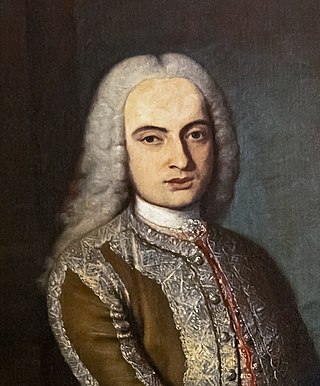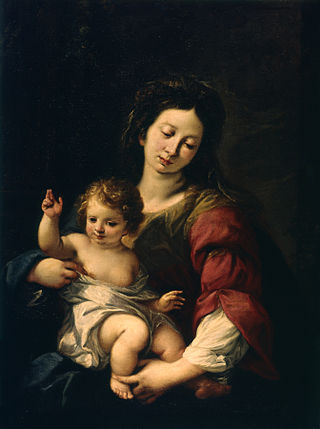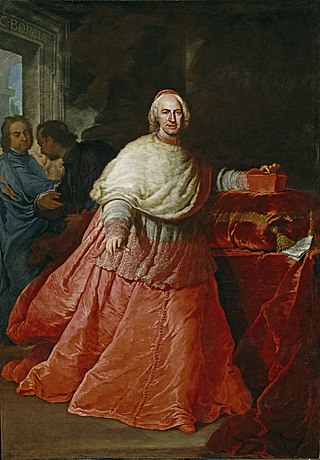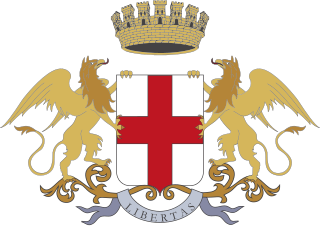Related Research Articles
Year 1350 (MCCCL) was a common year starting on Friday of the Julian calendar.

Gian Rinaldo Carli (1720–1795), also known by other names, was an Italian economist, historian, and antiquarian.

Carlo Francesco Nuvolone was an Italian painter of religious subjects and portraits who was active mainly in Lombardy. He became the leading painter in Lombardy in the mid-17th century, producing works on canvas as well as frescoes. Because his style was perceived as close to that of Guido Reni he was nicknamed il Guido della Lombardia.

The Way We Laughed is a 1998 Italian film directed by Gianni Amelio. It tells the story of two Sicilian brothers, Giovanni and Pietro, who emigrate to the city of Turin. Giovanni works hard to help Pietro study to be a teacher, but Pietro does poorly. Then Pietro disappears.
Pietro da Pietri was an Italian painter of the late-Baroque period, active mainly in Rome.

Giuseppe Passeri was an Italian painter of the Baroque period, active in his native city of Rome.

Andrea Procaccini was an Italian painter of the Baroque period, active in Rome as well as in Spain.

Pasquale de' Rossi, also known as Pasqualino de' Rossi, was an Italian painter of the Baroque period.

Gaetano Lapis (1706-1773) was an Italian painter of the late-Baroque period.

Giovanni Maria Viani (1636–1700) was an Italian painter of the Baroque period, active in Bologna.

Karel van Vogelaer or Carel de Vogelaer, nicknamed Distelbloem was a Dutch still life painter from Maastricht primarily active in Italy where he was known as 'Carlo dei Fiori'. He made a name with his elaborate Baroque flower pieces often with figures painted in by other artists.

Sebastiano Ghezzi (1580–1645) was an Italian painter and architect of the Baroque period.

Michelangelo or Michelangiolo Cerruti was an Italian painter of the Baroque period, active mainly in Rome.

Franz Werner von Tamm (1658–1724) was a German Baroque painter who travelled to and worked in Italy.

Giovanni Paolo Lolmo was an Italian painter of the late-Renaissance period, active mainly in his native city of Bergamo. He is also known as Gian Paolo Lolmo. In 1587, he painted Saint Rocco and Sebastian for Santa Maria Maggiore (Bergamo).

Giovanni di Murta was elected the second Doge of the Republic of Genoa after the resignation of Simone Boccanegra, on 25 December 1345. His dogate was dominated by his attempts to break the circle of political violence which had crippled the city over the past century and to reassert Genoese dominion over the Mediterranean colonies.

Giovanni II Valente was the third doge of the Republic of Genoa. His time in office was marked by the crushing defeat of the city against the Venetians at the naval Battle of Alghero. Giovanni had already asked to succeed the first doge of the Republic in December 1345 but had turn down the responsibility.

The Capistrello massacre was a mass killing carried out in Capistrello, a small town in Abruzzo, Italy, on 4 June 1944 by Nazi and Fascist occupation troops during World War II. A first tragical episode occurred a few months earlier on 20 March, when a local youth was barbarically tortured and then shot. The following roundup made by Nazis and Fascists on the slopes of Mount Salviano led to the capture and torture of 33 shepherds and breeders. The shooting occurred near Capistrello railway station.
Giovanni Rosini was an Italian writer and art historian.
References
- Rosini, Giovanni (1847). Storia della Pittura Italiana esposta coi Monumenti, (Época Quarta: Dal Carraci al' Appiani); Volume VII. Presso Niccolò Capurro, Pisa; Original from Oxford University digitized Jan 4, 2007. pp. 78.
Giovanni Rosini epoca quarta.